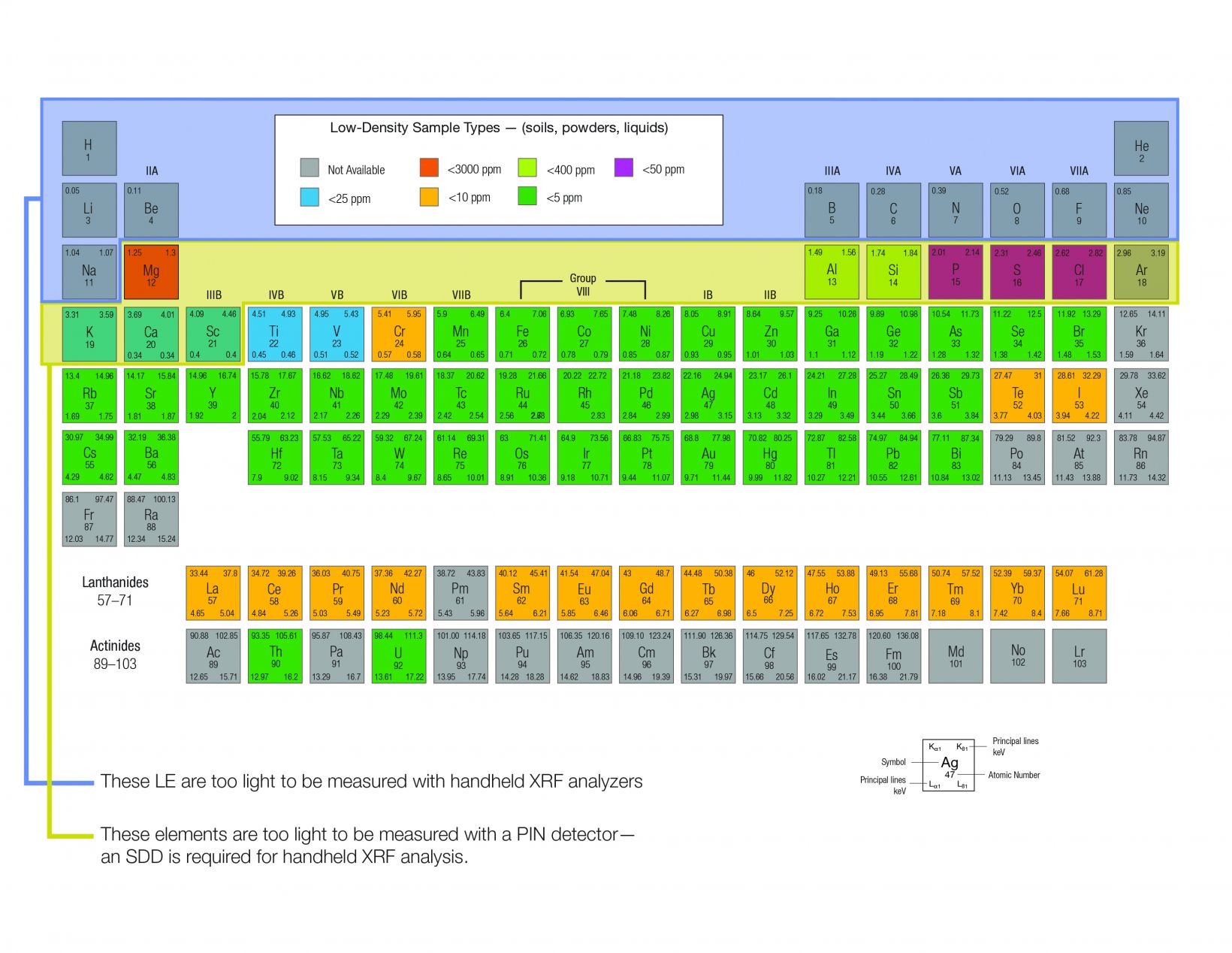There are many acronyms and abbreviations you may come across when learning about X-ray fluorescence (XRF). Use this quick reference guide to find the meaning of those you might find on our website or hear on the job.
XRF
XRF = X-ray fluorescence. This is a fast, nondestructive method to measure the elemental composition of a material. Learn more about how XRF works here.
Similar acronyms include:
- EDXRF = energy dispersive X-ray fluorescence. A fast, cost-effective XRF technique used in handheld XRF devices.
- WDXRF = wavelength dispersive X-ray fluorescence. An XRF laboratory technique that’s more expensive than EDXRF.
- HHXRF = handheld XRF
- pXRF = portable XRF
Detectors
Handheld XRF analyzers use two different types of detectors:
- PIN = silicon pin diode detector. An older, less expensive, and slower technology compared to SDD.
- SDD = silicon drift detector. A newer technology that can count 10x more X-rays per second than PIN.
Learn how to decide which detector type is best for you.
Elements
LE = light elements. The light elements have weaker X-ray energies that have difficulty reaching an XRF analyzer’s detector.
What is considered an LE depends on context. We frequently refer to the following elements that can be measured by handheld XRF as light elements:
- Magnesium (Mg)
- Aluminum (Al)
- Silicon (Si)
- Phosphorus (P)
- Sulfur (S)
- Chlorine (Cl)
- Potassium (K)
- Calcium (Ca)
These light elements are only measurable with an SDD.
Other times, LE refers to the elements with a low atomic number on the periodic table, which cannot be measured by handheld XRF analyzers. These elements include sodium (Na), carbon (C), hydrogen (H), and oxygen (O).
Hydrogen (H) to sodium (Na): these LE (highlighted in blue) are too light to be measured with handheld XRF analyzers. Magnesium (Mg) to scandium (Sc): these elements (highlighted in yellow) are too light to be measured with a PIN detector—an SDD is required for handheld XRF analysis.
Calibration Methods
FP = fundamental parameters. A calculation/calibration method used in XRF that takes into account the inter-element effects based on the fundamental physical properties of the atoms. FP is an important tool to get the right answer when the sample is dense (like most metals).
CN = Compton normalization. A simpler calculation/calibration method for less dense samples.
Material Identification
PMI = positive material identification. PMI is performed when the specific grade is of critical importance in equipment and parts like piping, valves, welds, and pressure vessels. It involves testing highly specific material chemistry to quickly and accurately identify alloy grades. Learn more about using handheld XRF for PMI.
Analysis
LOD = limit of detection. LOD is the lowest level we can detect the presence of a given element. At these very low levels it can be hard to quantify or put a number on the amount of an element.
LOQ = limit of quantification. The LOQ is about 3x higher than the LOD and is where you can become more confident in the numerical results.
Vanta Analyzer Models
Our Vanta™ XRF analyzer models have unique 3-letter acronyms to describe the different variations that meet customers’ application and analytical needs.
The 3-letter acronym represents three important components: Vanta, series, and X-ray tube type. Examples: VMR, VCR, VCA, and VLW. In the first example, V= Vanta, M = the M Series, and R = rhodium anode X-ray tube.
Find the full list of Vanta series options and tube types below:
Vanta Series
M, C, L: We used a Roman numeral to indicate the cost/performance level. The higher the Roman numeral, the better the performance. M Series is our highest performer, followed by the C Series, and then the L Series.
X-Ray Anode Tube Types
R = (Rh) rhodium anode X-ray tube. Best for measuring light elements. It’s notably fast at measuring magnesium (Mg), a key element in aluminum (Al) grades—making a rhodium anode X-ray tube the best choice for most alloy applications.
W = (W) tungsten anode X-ray tube. Using tungsten (W) or a similar heavy material is best for high-energy elements like cadmium, which is important for Restriction of Hazardous Substances (RoHS) testing.
A = (Ag) silver anode X-ray tube. Best all-around. Silver is not as good as rhodium for magnesium or tungsten for cadmium, but it’s a good compromise when on a budget.
We hope this list was helpful. Be sure to bookmark it for easy reference, and let us know if you have any other XRF acronyms we can add!
Related Content
Which XRF Analyzer Is Right for Me?
SDD vs. PIN Detector: Which One Do You Need for Handheld XRF?


